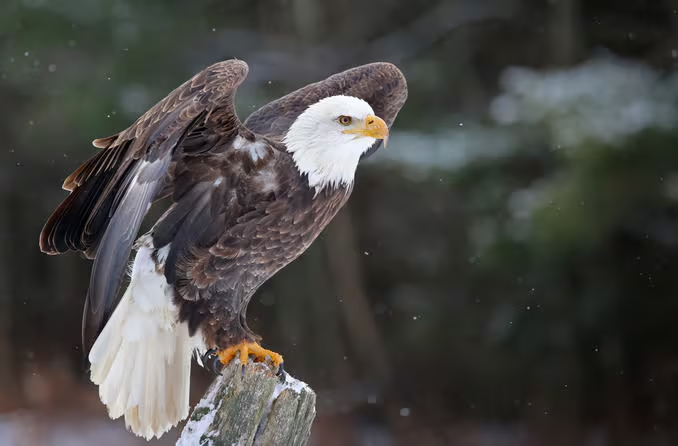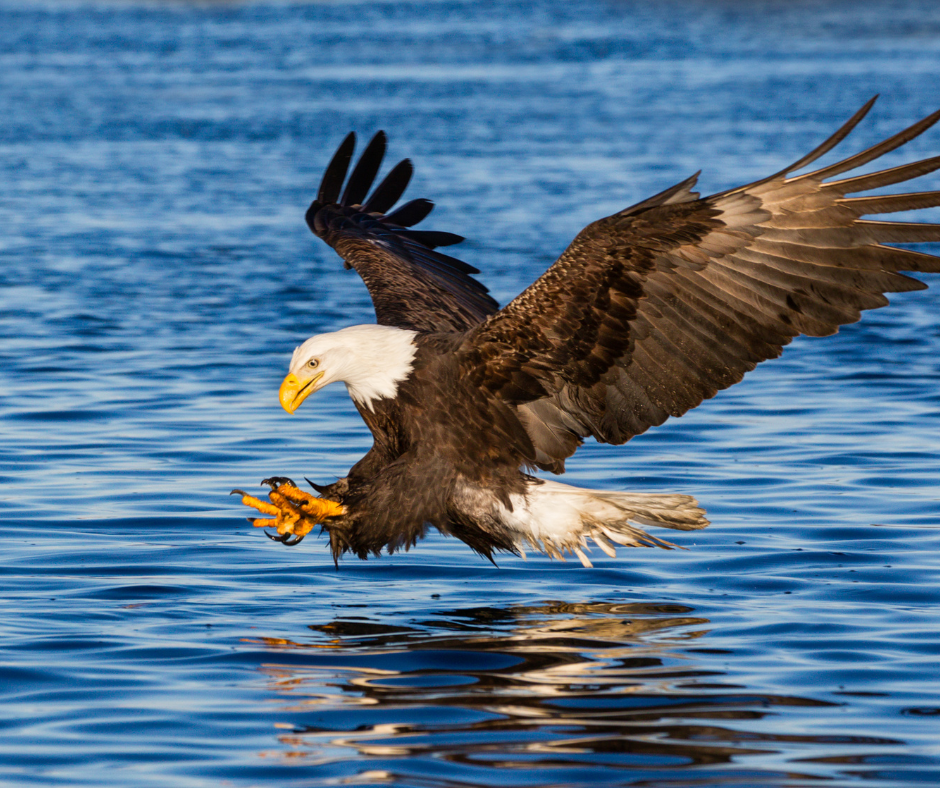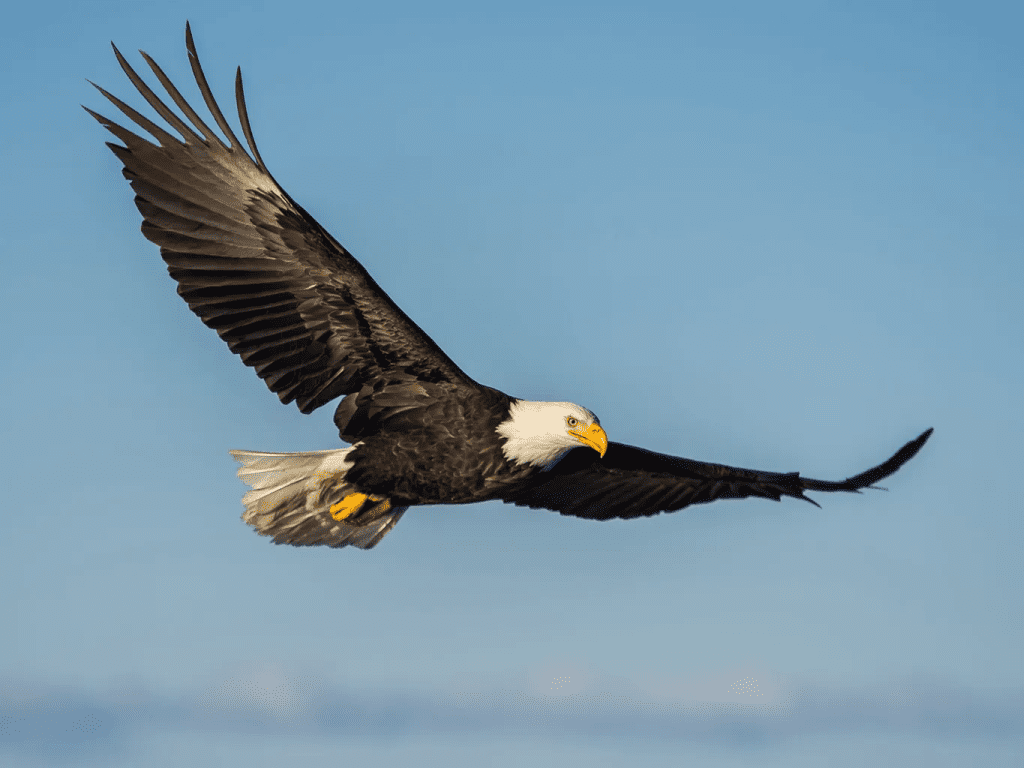Ever wondered how an eagle can swoop down from the sky and snatch a fish right out of the water with flawless precision? It’s not just skill — it’s next-level eyesight. Eagles are like flying cameras, equipped with ultra-high-definition vision that puts modern drone tech to shame.
These majestic birds don’t just glide through the air — they hunt with purpose. Their eyes are designed for the skies, and when you learn just how powerful their vision really is, it’s hard not to be amazed.
Eagle Vision: Better Than 20/20

Most humans consider 20/20 vision to be perfect. But eagles? They blow that out of the water.
Eagles are believed to have 20/5 vision, meaning they can see from 20 feet away what a human would only see clearly at 5 feet. That’s four times sharper than our best natural vision. This insane clarity allows them to pick up details we’d miss entirely — like a small fish flicking near the surface of a river, all from hundreds of feet in the air.
Imagine being able to spot a coin on the ground while standing on top of a 10-story building — that’s the eagle’s world.
Glare? Not a Problem for Eagles
Now, let’s talk about water. Even on a sunny day, the surface of a lake or river can be like a mirror — filled with glare and reflection. For us, it’s tough to see past it. But for eagles?
Their eyes are naturally equipped to filter out glare. They have a special structure in their retina that reduces the interference caused by reflected light, allowing them to cut through brightness and focus on movement beneath the surface. It’s like wearing polarized sunglasses — except built-in, and way more advanced.
Video : The Incredible Eyesight of Eagles: Nature’s Sharpest Vision
So while we might squint at a shiny lake, an eagle is already locked on to lunch.
Binocular Vision That Tracks Targets Mid-Air
You’ve probably heard the term “binocular vision” before — it’s what allows animals (and humans) to judge distance. Eagles have this too, but with a supercharged twist.
Their eyes face slightly forward, giving them excellent depth perception. And because they can move their heads smoothly while keeping their eyes locked on a target, they maintain laser focus even during high-speed dives. That means they can:
- Track a moving fish
- Calculate the angle of attack
- Time their dive to the millisecond
No second guesses. No hesitation. Just pure precision.
A Wide-Angle Field of View Without Losing Detail
Another wild fact? Eagles have a field of view of about 340 degrees — nearly a full circle. Yet somehow, they manage to maintain pinpoint detail in their central vision.
Their retinas are loaded with cone cells, which detect fine details and colors. This gives them a massive advantage: they can scan a huge area while simultaneously zooming in on one moving object. It’s like having both a panoramic lens and a telephoto lens active at the same time.
While you’re blinking at a blurry bird in the sky, the eagle already sees you — and probably knows what brand of hat you’re wearing.
How Eagles Use Vision to Hunt

Let’s break it down. Picture an eagle flying 300 feet above a river. It’s calm, quiet, and the water’s shimmering. Then, with almost no warning, the eagle changes course. Its wings pull in tight, and it drops like a missile.
Why? Because its eyes just caught a tiny flash beneath the surface — a fish swimming near the top.
The eagle:
- Adjusts its position mid-flight
- Times its dive perfectly
- Uses its talons to grab the fish — often without getting fully wet
This all happens in seconds. And it all begins with a flash of movement that you and I wouldn’t even notice.
Evolution Built the Ultimate Predator’s Eye
Eagles didn’t just wake up one day with superhero vision. This visual power is the result of millions of years of evolution, fine-tuned for survival.
Their eyesight helps them:
- Hunt more efficiently
- Avoid threats
- Navigate wide territories with ease

In the wild, vision is survival, and eagles have mastered that art. From open skies to dense forests, they rely on their vision more than anything else. It’s their secret weapon — and honestly, their superpower.
How Eagles Compare to Human Technology
Think your 4K drone is impressive? Eagles would laugh — if they could.
While drones rely on lenses and software to zoom and focus, eagles do it naturally and in real-time. No battery required. No GPS lag. Just pure instinct and biological design.
Their eyes offer:
- Superior motion detection
- Real-time tracking
- Optical clarity beyond anything man-made
In fact, researchers studying eagle vision have helped inspire improvements in camera lenses, tracking systems, and even augmented reality.
Why It All Matters: Nature’s Design Is Still Unmatched
Eagles remind us of something powerful — nature still does it better. We’ve created incredible tools and gadgets, but the eagle’s eye shows that evolution’s been doing high-tech for much longer.
Video : Just How Good is Eagle Vision?
Next time you see one soaring in the sky, take a moment. You’re looking at a living, breathing marvel — one that can see better, move faster, and hunt smarter than any drone or AI-powered camera.
Conclusion: Eyes on the Skies
Eagles aren’t just symbols of power — they’re visual masters of the natural world. With vision four times sharper than ours, built-in glare filters, and targeting precision that feels almost mechanical, they dominate the skies like no other.
Their eyes are their greatest weapon — and their greatest gift.
So, the next time you see an eagle circling high above, remember: it sees you… in more detail than you’ll ever see it. And that’s not magic — that’s evolution in high definition.
Think your eyes are sharp? Nature’s got you beat — try spotting a fish from 300 feet up.
My Son Drew Pictures of a Strange Man — When I Asked Him, He Said, ‘He Comes to See Mommy When You’re at Work’

I was stunned when my son started drawing a grinning stranger. “He comes to see Mommy when you’re at work,” Oliver said innocently. Initially dismissing it as a childish fantasy, I soon spied a mysterious man entering our home, igniting a chilling quest for the truth.
I found the drawing while tidying up the dining table. Most of Oliver’s pictures were what you’d expect from a six-year-old: dinosaurs with rainbow scales, our house with a chimney that looked more like a volcano, and stick figures of our family holding hands. But this one made me pause.

A man frowning at a drawing | Source: Midjourney
Among the crayon scribbles was a tall figure with unnaturally long arms and huge hands, wearing what looked like a suit. The figure had an enormous grin that stretched across most of its face.
“Oliver,” I called out, trying to keep my voice casual as my fingers crinkled the edge of the paper. “Is this me in the picture? Who is this?”
My son looked up from his LEGOs, his blue eyes bright with excitement.

An excited boy with a bright smile | Source: Midjourney
The plastic blocks clattered as he dropped them onto the hardwood floor. “That’s Mr. Smiles, Daddy! He’s Mommy’s new friend. He comes to see her when you’re at work.”
My heart skipped a beat. Laura and I had been married for nine years. We’d had our ups and downs like any couple, weathered job changes and family losses, and celebrated promotions and birthdays. But never, not once, did I think she’d…
No, I shook the thought away. There had to be a reasonable explanation. Laura wasn’t that kind of person. We’d built too much together.

A concerned man holding a paper | Source: Midjourney
“When does he come over?” I asked, proud of how steady my voice remained despite the tremor in my hands.
Oliver stacked another block on his tower, his tongue poking out in concentration.
“Sometimes in the morning. Sometimes at night. He always makes Mommy and me laugh.” He glanced up, suddenly serious, his small face scrunching with the weight of importance. “But, Daddy, it’s a secret! Don’t tell anyone!“

An emotional man standing in a living room | Source: Midjourney
The mention of laughter and secrecy felt like ice in my stomach.
That night, I barely slept, watching Laura’s peaceful face in the darkness. The steady rhythm of her breathing, once comforting, now felt like a taunt. Every time she shifted in her sleep, I wondered what she was dreaming about. Who she was dreaming about.
The next day, I left work early, parked down the street from our house, and waited. The fall air grew crisp as the afternoon wore on, and fallen leaves skittered across my windshield. A little after 3 p.m., a sleek black car pulled into our driveway.

A black car parked in a driveway | Source: Pexels
A tall, wiry man stepped out and marched up to the front door. Even from this distance, I could see his broad smile when Laura welcomed him inside. The door closed behind them.
I gripped my steering wheel until my knuckles turned white; the leather creaking under my fingers.
“Maybe this is all in my head,” I whispered to myself, watching my breath fog the window. “But if I’m wrong, I need to know for sure.”

A man sitting in a car | Source: Pexels
Over the next few weeks, I started buying Laura flowers and gifts, trying to rekindle our bond, but I also began documenting everything.
The evidence piled up: receipts for dinners I didn’t attend, calls she’d leave the room to take, and, of course, more pictures of “Mr. Smiles” drawn by Oliver. Each new piece of evidence felt like another brick in a wall being built between us.
Laura noticed the change in me.

A woman staring at her husband during dinner | Source: Midjourney
“Are you feeling okay?” she asked one day, touching my forehead with concern. “You seem distracted lately.”
The genuine worry in her voice only confused me more. How could she act so normal if she was hiding something so huge?
“I… do you have someone else?” I asked.
“Someone else?” Laura stared at me with wide eyes, then shook her head.

A woman looking at her husband with wide eyes | Source: Midjourney
“Of course not, honey!” She let out a little chuckle. “How could you think that?”
Maybe I should’ve confronted her then, but all my evidence was circumstantial. I needed cold, hard proof.
One Friday evening, I told Laura I’d be working late. Instead, I set up a hidden camera on the bookshelf in the living room and watched the feed from my car parked around the corner.

A bookshelf in a living room | Source: Pexels
The screen of my phone cast a blue glow across my face as I waited, my coffee growing cold in its cup holder.
Right on schedule, Mr. Smiles arrived, and Laura greeted him with that same warm smile that used to be reserved for me.
But then something strange happened. He didn’t settle on the couch or share a private dinner. Instead, my sister walked in, and Oliver came bounding down the stairs with a beaming smile. More people arrived: neighbors and friends!

A man looking at his phone in confusion | Source: Midjourney
They all knew about this? And worse, they were having a secret get-together! I watched in stunned silence as Mr. Smiles, now wearing a festive party hat, juggled three oranges for Oliver and made him laugh.
“What the heck is going on?” I muttered, fumbling with my car door.
Rage and confusion propelled me toward the house. The evening air felt thick and heavy as I stormed up our front walk. I burst through the front door, making everyone freeze mid-conversation, the cheerful music cutting off abruptly.

A group of people in a living room staring at someone in surprise | Source: Midjourney
“Alright, you won,” I said, my voice trembling. “Everyone here knew, didn’t they? Even Oliver? Even my sister?”
“No, no! Please, stop!” Laura’s face had gone pale, her hands clutching a roll of streamers that cascaded to the floor.
I turned to Mr. Smiles, who had stopped juggling and was staring at me with wide eyes.
“You’ve disrespected me as a man, and you’ve got no business being here! It’s my house! It’s my…”
My voice trailed off as I spotted something shiny on the floor.

A man speaking angrily to someone | Source: Midjourney
A banner, not yet hung, with golden letters that read “Happy 10th Anniversary!” The metallic paper caught the light from our living room lamps, throwing sparkles across the ceiling.
The room went completely silent. Laura’s hands covered her mouth, tears welled in her eyes, and she smudged her carefully applied makeup. Mr. Smiles cleared his throat and stepped forward, his famous grin nowhere to be seen.
“Sir, I think there’s been a misunderstanding,” he said softly, his professional demeanor never wavering. “I’m a wedding planner and party animator. Your wife hired me months ago to plan this event — your wedding anniversary!”

A man speaking in a living room | Source: Midjourney
“You thought I was cheating on you?” Laura’s voice cracked with hurt and disbelief, each word falling like a stone between us.
I felt the floor shift beneath my feet. The room suddenly seemed too bright, too crowded, the decorations garish and mocking.
“I… I didn’t know what else to think,” I stammered, my collar feeling too tight. “I saw him coming here, and Oliver said a man kept visiting while I was at work, that this man made you laugh…”

An emotional man looking confused and shocked | Source: Midjourney
“Oliver said he made me laugh because he does magic tricks for him when we plan,” Laura interrupted, her voice rising. “I was trying to do something special for you, and you thought I was unfaithful?”
My throat felt tight. “I’m sorry,” I managed to say, the words feeling inadequate. “I was wrong. I let my insecurities get the better of me.”
Laura wiped her eyes with the back of her hand, leaving a dark smudge of mascara. “How could you think that? After everything we’ve been through?”

An emotional woman speaking to her husband | Source: Midjourney
The party guests began quietly filing out, murmuring awkward goodbyes, their shoes shuffling across our carpet.
My sister squeezed my shoulder as she left, whispering, “Fix this.” Oliver looked confused and scared, so Laura’s mother took him upstairs to his room, their footsteps echoing in the tense silence.
When we were finally alone, Laura sat on the couch, her shoulders slumped. The streamers lay in tangles around her feet.

An upset woman sitting on a sofa | Source: Midjourney
“I spent months planning this,” she said quietly. “I wanted it to be perfect. Remember our first anniversary? When you surprised me with that picnic in the park? I wanted to do something just as special.”
I sat beside her, careful to leave space between us, the cushions dipping under my weight. “I ruined everything.”
“Yes, you did.” She turned to look at me, her eyes red but fierce. “Trust isn’t just about believing in someone when everything’s perfect. It’s about believing in them when things don’t make sense.”
“I know,” I whispered, feeling the weight of my mistake. “I forgot that somewhere along the way. Can you forgive me?”

A couple having a serious conversation | Source: Midjourney
Laura was quiet for a long moment, her fingers tracing patterns on the fabric of her dress.
“I love you,” she said finally. “But this isn’t something I can just get over. You need to understand how much this hurts.”
I nodded, feeling tears start to fall. “I’ll do whatever it takes to make this right.”
“It won’t happen overnight,” she warned, her voice stern but not unkind.

A stern-looking woman speaking to someone | Source: Midjourney
“I know. But I’m not going anywhere.” I reached for her hand, and after a moment’s hesitation, she let me take it, her fingers cool against my palm. “Happy anniversary,” I said softly.
She gave a watery laugh that held both forgiveness and reproach. “Happy anniversary, you idiot.”
Upstairs, we heard Oliver laughing at something, probably one of his grandmother’s stories. The sound filled our living room, reminding us of all we had to lose, and all we had to save.

A couple in a living room glancing upwards | Source: Midjourney
This work is inspired by real events and people, but it has been fictionalized for creative purposes. Names, characters, and details have been changed to protect privacy and enhance the narrative. Any resemblance to actual persons, living or dead, or actual events is purely coincidental and not intended by the author.
The author and publisher make no claims to the accuracy of events or the portrayal of characters and are not liable for any misinterpretation. This story is provided “as is,” and any opinions expressed are those of the characters and do not reflect the views of the author or publisher.



Leave a Reply